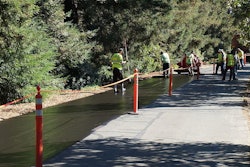Along with spring flowers, the end of winter brings the sealcoating season to a start. Professionalism and customer care are the hallmarks of any successful business. In the sealcoating business, professionalism and customer care involve making sure protections are in place that have been proven to maximize the quality of the sealcoating job and, with a job done right, customer satisfaction.
Protect yourself and your employees. Make sure you and your applicator teams are familiar with any product specifications and information distributed by the supplier of the product used on each job, including the Safety Data Sheet (SDS). Make sure your applicator teams are properly outfitted for the job, including wearing appropriate clothing, gloves and, if conditions warrant, a hat and face shield. Your sealcoat supplier may recommend other personal protective measures as well – following manufacturer’s recommendations is an important practice. Ensuring that your employees are protected is as key to a successful job as checking that your equipment is in working order and that there are no leaks.
Protect the environment. While planning the project, talk to the customer and visit the site to identify any natural resources or possible environmentally sensitive areas that are priorities for protection. Use storm drain barriers and block to keep the emulsion on the asphalt surface. Sealcoats are water-based emulsions that cure over time. The length of curing time varies with temperature and humidity. Typically, product suppliers include information about curing times with product specifications. If it rains too soon after application, a wash off can occur. DO NOT APPLY SEALCOAT IF RAIN IS IN THE FORECAST. A 24-hour forecast window is usually safe, but follow your supplier’s recommendations as some add a drying agent to speed curing. Like the general public, research scientists don’t have practical knowledge about sealcoat, but they have heard about the wash off at the University of New Hampshire storm water engineering facility – it rained within a day after the late-season (cool temperatures combined with high humidity) application. This incident happened at the beginning of UNH’s 2-year sealcoat storm water runoff experiment. Scientists reading about the UNH experiment think this was a normal occurrence -- a misconception that has influenced regulators view of the industry ever since. In the hot summer months, thunderstorms can develop quickly, which leads to the reminder to BE AWARE OF THE CHANCE OF THUNDERSTORMS. A week or two after application, sweep the sealcoated area to remove any loose particles. Never dispose of leftover emulsion down a drain or a storm sewer or in any body of water. Dried sealer can be disposed of as industrial waste. When in doubt about storage or disposal of excess product, ask your supplier.
Protect your customer. Give your customer clear instructions about how long to wait before allowing light and, if appropriate, heavy vehicles to use the newly sealcoated surface. Clean up after completion of the job, and don’t leave excess emulsion or unapplied dry sealcoat on your customer’s property without permission. Communication with your customer is the key to avoiding misunderstandings about the do’s and don’ts of freshly sealcoated surfaces.
Follow these practices and you’ll be on the way to quality jobs and satisfied customers.




















